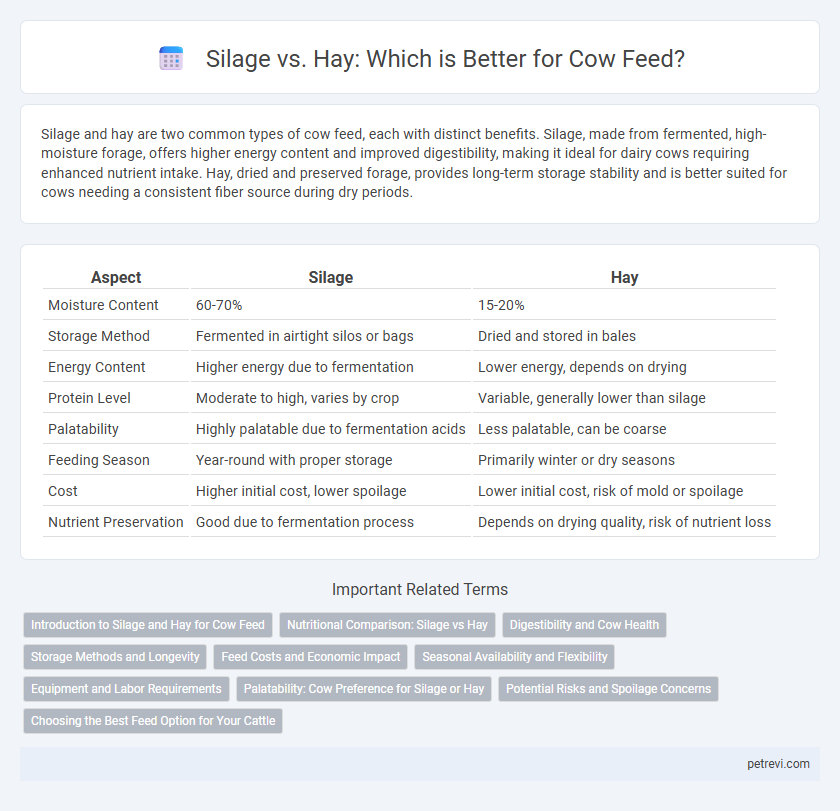Silage and hay are two common types of cow feed, each with distinct benefits. Silage, made from fermented, high-moisture forage, offers higher energy content and improved digestibility, making it ideal for dairy cows requiring enhanced nutrient intake. Hay, dried and preserved forage, provides long-term storage stability and is better suited for cows needing a consistent fiber source during dry periods.
Table of Comparison
| Aspect | Silage | Hay |
|---|---|---|
| Moisture Content | 60-70% | 15-20% |
| Storage Method | Fermented in airtight silos or bags | Dried and stored in bales |
| Energy Content | Higher energy due to fermentation | Lower energy, depends on drying |
| Protein Level | Moderate to high, varies by crop | Variable, generally lower than silage |
| Palatability | Highly palatable due to fermentation acids | Less palatable, can be coarse |
| Feeding Season | Year-round with proper storage | Primarily winter or dry seasons |
| Cost | Higher initial cost, lower spoilage | Lower initial cost, risk of mold or spoilage |
| Nutrient Preservation | Good due to fermentation process | Depends on drying quality, risk of nutrient loss |
Introduction to Silage and Hay for Cow Feed
Silage and hay are two primary types of forage used to feed cows, each with distinct preservation methods and nutritional profiles. Silage is fermented, high-moisture stored fodder that retains more nutrients and energy compared to dry hay, which is air-dried grass or legumes. Choosing between silage and hay depends on factors like climate, storage facilities, and the specific dietary needs of dairy or beef cattle.
Nutritional Comparison: Silage vs Hay
Silage contains higher moisture content and preserves more nutrients like protein and energy compared to hay, making it a more digestible feed option for cows. Hay, while drier and easier to store, often loses some vitamins such as vitamin A during the curing process. The nutritional differences impact milk production and growth rates, with silage generally supporting better overall cattle performance.
Digestibility and Cow Health
Silage offers higher digestibility compared to hay due to its moisture content and fermentation process, which enhances nutrient absorption in cows. Properly fermented silage promotes better rumen health by encouraging beneficial microbial activity and reducing digestive disorders. In contrast, hay, while easier to store, may have lower digestibility and can increase the risk of respiratory issues from dust and mold exposure.
Storage Methods and Longevity
Silage is stored in anaerobic conditions, such as silos or plastic-wrapped bales, which preserves moisture and nutrients for up to 12 months, making it highly durable in varying climates. Hay, dried to about 15% moisture, is stored in well-ventilated barns or covered areas to prevent mold, with a typical shelf life of 6 to 12 months depending on storage quality. Proper storage of either feed type is crucial to maintain feed quality and prevent spoilage, directly impacting cow health and milk production.
Feed Costs and Economic Impact
Silage typically offers a cost-effective alternative to hay due to its higher nutritional density and lower storage losses, reducing overall feed expenses for dairy and beef operations. The fermentation process in silage preserves more nutrients, leading to better feed conversion efficiency and potentially higher milk or weight gains, which positively impact farm profitability. Hay production involves higher labor and equipment costs, with greater susceptibility to weather-related spoilage, making silage a more economically viable option in many regions.
Seasonal Availability and Flexibility
Silage offers superior flexibility for cow feed due to its fermentation process, allowing storage and use throughout different seasons, especially during wetter or colder months when fresh forage is scarce. Hay, on the other hand, relies heavily on dry weather during harvest season, making its availability more seasonal and susceptible to climate variability. Producers often combine both to ensure consistent feed quality and nutrient supply year-round.
Equipment and Labor Requirements
Silage production for cow feed requires specialized equipment such as forage harvesters, silage wagons, and silos, leading to higher initial investment and maintenance costs compared to haymaking. Hay harvesting demands equipment like mowers, rakes, tedders, and balers, which are generally less expensive and labor-intensive than silage machinery. Labor requirements for silage involve careful timing and management of cutting, packing, and sealing to ensure proper fermentation, while hay requires multiple field operations including cutting, drying, and baling with more hands-on monitoring to prevent spoilage.
Palatability: Cow Preference for Silage or Hay
Cows generally prefer silage over hay due to its higher moisture content and softer texture, which enhance palatability and ease of chewing. Silage retains more nutrients and natural sugars, making it more appealing and digestible for cattle. However, hay remains a valuable feed option, especially during dry seasons when silage quality may decline.
Potential Risks and Spoilage Concerns
Silage for cow feed carries potential risks such as mold growth, mycotoxin contamination, and spoilage due to improper fermentation or storage conditions, leading to decreased nutritional value and possible health issues. Hay, while generally more stable, can suffer from spoilage if stored wet, causing mold and dust that threaten respiratory health and reduce feed quality. Proper management and monitoring of moisture levels and storage environment are critical to minimizing spoilage and ensuring safe, nutritious feed for cows.
Choosing the Best Feed Option for Your Cattle
Silage provides high moisture content and preserves nutrients through fermentation, making it ideal for maintaining cattle energy levels during winter or drought conditions. Hay offers a dry, long-lasting feed option rich in fiber, essential for proper rumen function and digestion in cows. Selecting the best feed depends on factors like forage availability, weather conditions, and the specific nutritional needs of your herd to optimize health and milk production.
Silage vs Hay for Cow Feed Infographic

 petrevi.com
petrevi.com